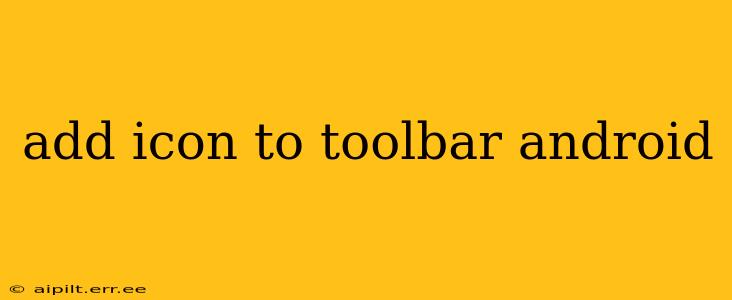Adding icons to your Android Toolbar is a fundamental aspect of creating a user-friendly and visually appealing app. This guide provides a comprehensive walkthrough, covering various methods and considerations to ensure your icons are implemented effectively and efficiently. We'll address common questions and best practices to help you achieve a polished and professional result.
Understanding the Android Toolbar
Before diving into the implementation, let's briefly understand the role of the Toolbar. In modern Android development, the Toolbar widget replaces the older ActionBar and serves as a primary interface element for displaying app titles, navigation, and actions. Adding icons allows you to represent actions concisely, improving usability and enhancing the user experience.
Method 1: Using the XML Layout File (Recommended)
This is generally the preferred method as it keeps your layout clean and organized. You define your icons directly within your XML layout file.
Steps:
-
Add the icon to your
drawablefolder: Place your icon image (typically a.pngor.svg) in your project'sres/drawablefolder (or a density-specific folder likedrawable-hdpi,drawable-xhdpi, etc.). -
Include the
Toolbarin your layout XML:
<androidx.appcompat.widget.Toolbar
android:id="@+id/toolbar"
android:layout_width="match_parent"
android:layout_height="?attr/actionBarSize"
android:background="?attr/colorPrimary"
android:elevation="4dp"
android:theme="@style/ThemeOverlay.AppCompat.ActionBar"
app:popupTheme="@style/ThemeOverlay.AppCompat.Light"/>
- Add the menu resource file: Create a new XML file (e.g.,
menu/my_menu.xml) in yourres/menufolder. This file defines the menu items that will appear in your Toolbar:
<?xml version="1.0" encoding="utf-8"?>
<menu xmlns:android="http://schemas.android.com/apk/res/android"
xmlns:app="http://schemas.android.com/apk/res-auto">
<item
android:id="@+id/action_settings"
android:icon="@drawable/ic_settings"
android:title="@string/action_settings"
app:showAsAction="ifRoom"/>
<item
android:id="@+id/action_search"
android:icon="@drawable/ic_search"
android:title="@string/action_search"
app:showAsAction="ifRoom|collapseActionView"
app:actionViewClass="androidx.appcompat.widget.SearchView"/>
</menu>
- Inflate the menu in your Activity: In your Activity's
onCreatemethod, inflate the menu:
Toolbar toolbar = findViewById(R.id.toolbar);
setSupportActionBar(toolbar);
getSupportActionBar().setDisplayShowTitleEnabled(false); //Optional: Hide the default title
@Override
public boolean onCreateOptionsMenu(Menu menu) {
getMenuInflater().inflate(R.menu.my_menu, menu);
return true;
}
- Handle menu item clicks (optional): Implement the
onOptionsItemSelectedmethod to handle clicks on your menu items:
@Override
public boolean onOptionsItemSelected(MenuItem item) {
switch (item.getItemId()) {
case R.id.action_settings:
// Handle settings action
return true;
case R.id.action_search:
// Handle search action
return true;
default:
return super.onOptionsItemSelected(item);
}
}
Method 2: Programmatically Adding Icons
While less common for simple icons, this method offers more flexibility for dynamic icon changes.
Steps:
-
Create an
ImageViewprogrammatically and set its source to your drawable. -
Add the
ImageViewto theToolbarusingToolbar.addView().
This approach requires more manual management and is generally less preferable for static icons.
Frequently Asked Questions (FAQs)
How do I change the icon size in the Toolbar?
You can control the icon size using styles and themes, or by directly setting the android:layout_width and android:layout_height attributes within your menu XML. However, it's crucial to maintain consistency with the overall app design.
Can I use vector drawables for my Toolbar icons?
Yes, vector drawables are highly recommended. They scale seamlessly across different screen densities, resulting in a crisper look and smaller APK size.
How do I handle icon clicks?
As shown in the example above, use the onOptionsItemSelected method to capture clicks on your menu items and handle the corresponding actions.
What are the best practices for designing Toolbar icons?
Use clear, concise, and universally understood icons. Maintain consistency in style and size. Ensure sufficient contrast for readability. Consider using well-established icon sets or creating your own consistent set.
By following these steps and incorporating best practices, you can effectively add icons to your Android Toolbar, significantly enhancing the user experience and overall app design. Remember to always test your implementation across various devices and screen sizes.
